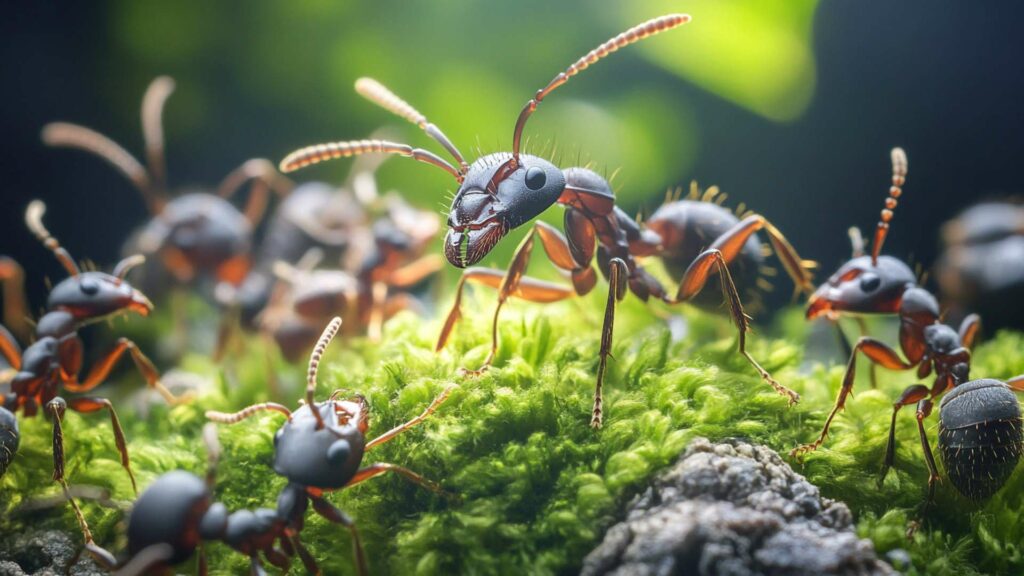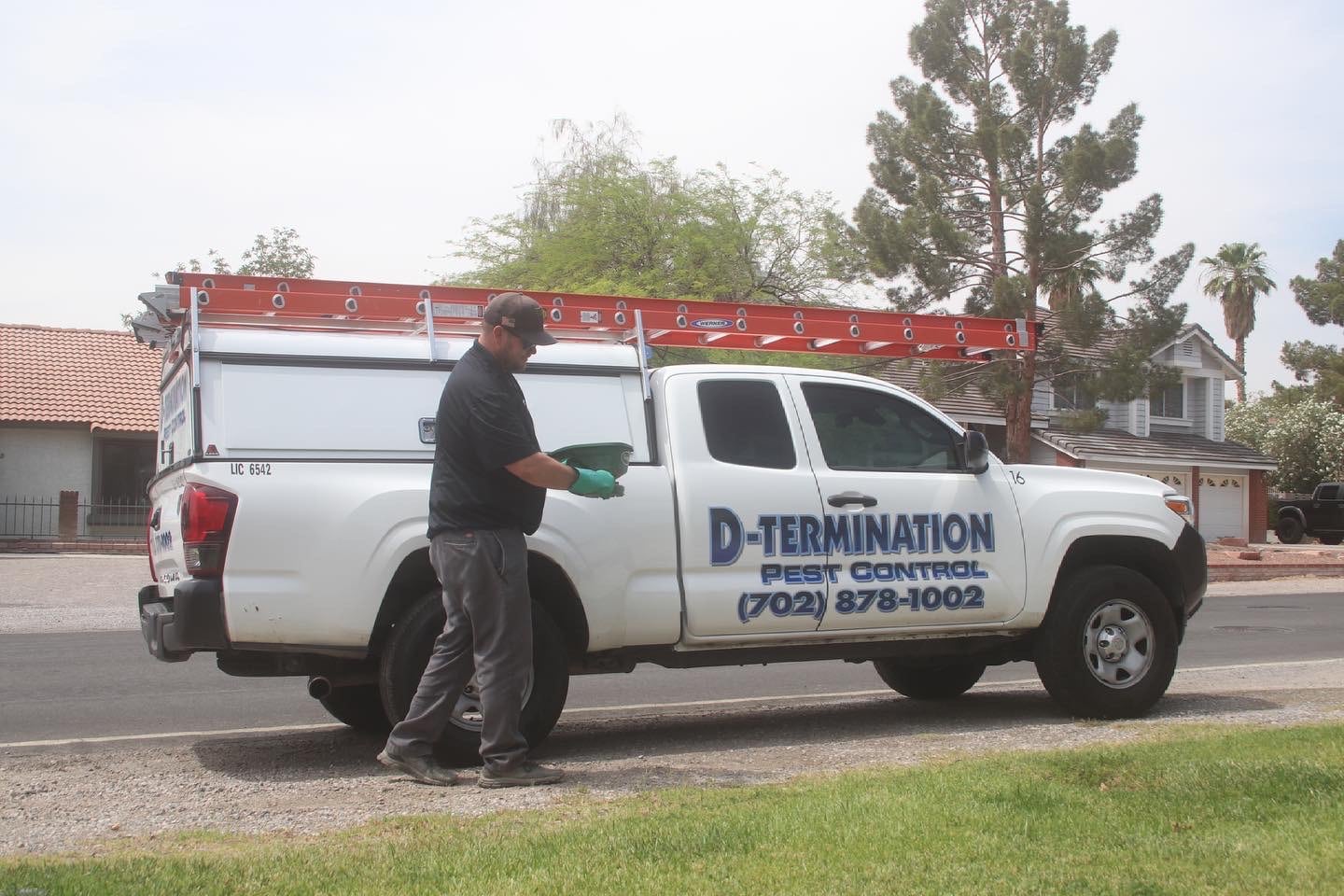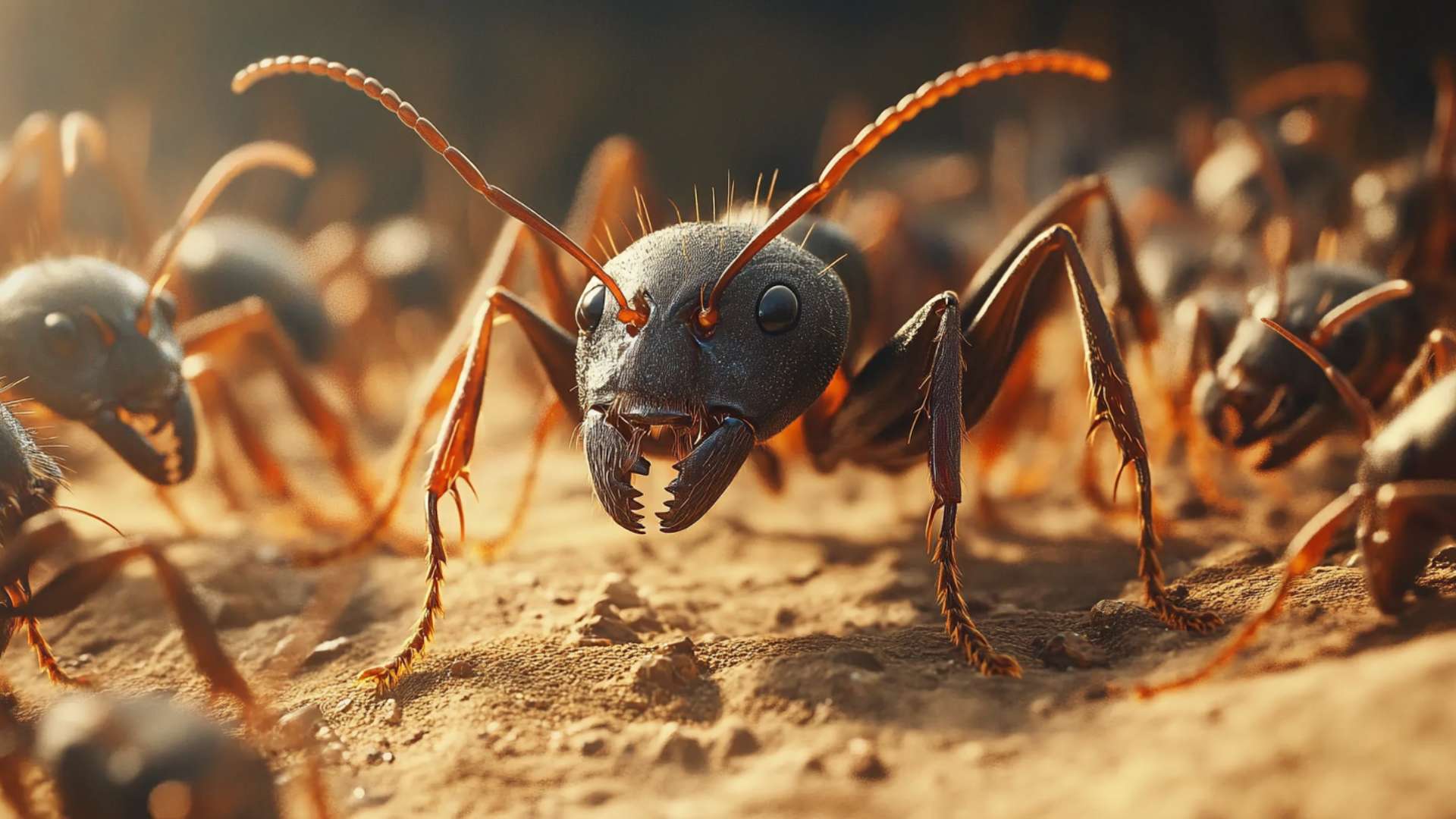Carpenter ants, while often mistaken for termites, are fascinating creatures that exhibit remarkable nesting habits. Unlike termites that consume wood, carpenter ants simply excavate it to create their nests.
These industrious insects can be found in various habitats such as forests, gardens, or even within the framework of our residential structures. Carpenter ants are commonly known for their black or reddish-brown coloration and can range in size from a quarter-inch to an inch long.
They have segmented bodies with a distinct narrow waist and bent antennae. While these ants primarily reside outdoors in rotting logs or tree stumps where they play crucial roles in decomposition and nutrient cycling, they sometimes find their way into our homes seeking food or suitable nesting sites.
Understanding the nesting habits of carpenter ants is essential for effective pest control measures, as it allows us to identify their habitats and take appropriate action. Let’s delve deeper into the intriguing world of carpenter ant nests and shed light on their intricacies.
Brief Explanation of Carpenter Ants

Carpenter ants belong to the genus Camponotus and are known for their impressive ability to build nests within wood. These social insects live in large colonies consisting of workers, soldiers, winged ants, reproductive individuals (often referred to as swarmers), and a queen who serves as the reproductive powerhouse. The primary function of worker ants is to expand and maintain the nest structures while carrying out various tasks such as foraging for food sources like dead insects or sweet substances.
Soldiers are responsible for defending the parent colony against potential threats, while winged reproductive individuals emerge during specific times of the year to establish new colonies elsewhere. In terms of nesting habits, carpenter ants prefer decaying wood with high moisture content as it provides them with a suitable environment for their activities.
These ants can be found in both natural outdoor settings and man-made wood structures, such as houses or wooden furniture. It is important to note that carpenter ants, while capable of causing structural damage over time, do not consume wood but rather excavate it to create galleries for nesting and movement.
External Nest Characteristics

Location Preferences (e.g., trees, wooden structures)
Carpenter ants, unlike termites, do not eat wood but instead excavate it to create their nests. These resourceful critters show a strong affinity for wooden structures and trees in particular. They are often found nesting in decaying or moist wood, making them a potential threat to your home’s structural integrity.
Trees with hollowed trunks or branches provide an ideal environment for these pests to establish their colonies. Additionally, carpenter ants may also infest wooden fences, decks, sheds, or even rustic furniture if it is hollow sound provides suitable nesting conditions.
Nest Entrances and Exit Holes

To have other ants access their nests within the wooden structure, carpenter ants create entrance and exit holes. These openings are typically small but can be visible upon close inspection.
Look out for round or oval-shaped openings that are meticulously carved out by the worker ants with their powerful mandibles. The size of these holes can vary depending on the ant’s role within the colony—workers usually create smaller entrances while larger holes may indicate soldier ant activity.
Signs of Sawdust or Frass around the Nest Area

One common sign of a carpenter ant infestation is the presence of sawdust-like material known as frass near dead ants’ nest entrances or surrounding areas. Worker ants push this debris out of the nest through tiny crevices as they excavate galleries and tunnels inside the wood.
Frass consists of wood shavings mixed with ant excrement and discarded debris from nest construction activities. As you inspect potential nesting sites around your property, keep an eye out for piles of frass near wooden structures or trees where carpenter ants might be active.
The frass itself may have a granular texture resembling coarse sand and could contain remnants of insect body parts or small wood fragments. It is essential to address these signs promptly to prevent further carpenter ant damage and potential structural issues.
Remember, if you suspect a carpenter ant problem, it is advisable to consult with a pest control professional experienced in carpenter ant control. While identifying the external characteristics of their nests can provide valuable insight, addressing the underlying infestation requires expert knowledge and effective treatment strategies.
Galleries and Tunnels: A Complex Network of Ant Highways
When you peer into the intricate world of a carpenter ant colony nest, you will discover a mesmerizing web of galleries and tunnels. Like a bustling city with its busy streets, these passageways serve as the main transportation system for the ants. Workers scurry through these narrow corridors, carrying food, communicating with one another, and attending to various tasks essential for the colony’s survival.
What’s truly fascinating is that carpenter ants create different sizes of tunnels to accommodate their distinct roles within the colony. Just as we have highways for cars and pedestrians alike, carpenter ants have “highways” suitable for workers, soldiers, and even queens.
These varying tunnel sizes not only facilitate movement but also enable efficient distribution of responsibilities among different carpenter ant extermination castes. To ensure smooth passage within these tunnels, carpenter ants employ their powerful mandibles.
These mouthparts are not only used for chewing through wood but also in excavating passageways within it. As they burrow deeper into wooden structures or trees, they carefully shape and polish the tunnel walls using their mandibles.
The result? Smooth surfaces that allow ants to navigate swiftly without any obstructions.
Chambers: Nurturing Life Within
A carpenter ant nest consists of more than just empty hallways; it includes chambers dedicated to specific tasks crucial for the colony’s prosperity. Among these chambers are specialized spaces known as brood chambers – essential nurseries where eggs are laid, larvae develop, and pupae transform into adult ants.
Brood chambers are carefully constructed to provide optimal conditions for growth and development. The queen painstakingly selects suitable locations within the nest where temperatures remain stable and humidity levels are just right to ensure her offspring’s well-being.
Additionally, carpenter ants have designated food storage chambers to sustain the entire colony. These chambers serve as pantries, where workers store provisions collected from their foraging activities.
The stored food – which can include insects, plant matter, and even sugary substances like honeydew from scale insects – ensures a constant supply to meet the nutritional needs of the carpenter ant swarms and community. So next time you come across carpenter ant damage or spot one of their swarming flights, remember that beneath the surface lies a hidden world of intricate galleries and carefully designed chambers that support and nurture an entire colony.
Nesting Materials

Wood Preferences of Carpenter Ants: Moisture Content, Decayed Wood
Submerged within the realm of nature’s architects, carpenter ants find solace and sustenance in the heartwood of trees or the structural timbers of our homes. These industrious insects are highly discerning when it comes to their choice of abode.
Carpenter ants may seem like mere pests, but they possess an innate wisdom in selecting wood with just the right amount of moisture content and decay. Unlike their termitic counterparts whose voracious appetites devour wood indiscriminately, carpenter ants prefer to establish their nests in wood that has been softened by age or moisture.
They gravitate towards decaying, tree limbs, stumps, fallen logs, and even damp wooden structures where humidity has taken its toll. The moisture-laden environment promotes favorable conditions for these ambrosial creatures to thrive and build their intricate dwellings.
Excavated Wood Debris Used to Construct Galleries
The bustling microcosm inside a carpenter ant’s nest witnesses constant activity as worker ants tirelessly excavate tunnels and galleries within the chosen wooden sanctuary. Armed with their straight antennae gently swaying with each step, these diligent architects meticulously transform solid timber into a labyrinthian masterpiece. With unwavering focus and precision, worker ants employ their mandibles as tiny yet formidable tools.
They adeptly carve through timber fibers, transforming sturdy planks into a network of intricately constructed passages. Meanwhile, discarded wood shavings fall gracefully to the ground below like confetti from an unseen celebration.
These excavated wood debris not only serve as testament to the artistry unfolding within but also provide vital structural support for the newfound colony. As worker ants diligently clear pathways through solid matter, they create ample space for nest expansion while ensuring stability amidst this thriving subterranean universe.
In their quest for comfort and sustenance, carpenter ants demonstrate a delicate balance of architectural prowess and resourcefulness. Their choice of wood, with optimal moisture content and decay, sets the stage for an intricate tapestry of tunnels.
From the depths of these well-crafted galleries, worker ants orchestrate their daily routines and nurture the future generations that will continue the legacy. It is within this hidden realm that these remarkable creatures showcase their expertise in transforming decayed wood into a sanctuary tailored to their exact needs.
Satellite Nests
The Hidden Extensions of Carpenter Ant Colonies
When exploring the fascinating world of carpenter ant nests, one cannot disregard the existence of satellite colonies. These satellite nests act as extensions of the main parent nest, serving specific purposes within the expansive social structure of these resilient insects.
Understanding the significance of these satellite colonies is crucial when devising effective pest control strategies to prevent carpenter ants from wreaking havoc on our beloved wooden structures. Carpenter ant colonies often consist of a central nest alongside several smaller satellite nests scattered nearby.
These satellite nests serve various functions like brood rearing, food storage, and even waste disposal. The presence of these additional nests ensures that essential activities are distributed throughout the colony’s territory, providing efficiency and adaptability to their complex social organization.
The implications for pest control strategies are significant when considering these satellite colonies. Merely eliminating visible outdoor nests or treating the main nest may prove insufficient in eradicating an entire colony.
If overlooked, hidden satellite colonies in wall voids or other hollow spaces can go unnoticed and continue to thrive despite initial extermination attempts. A comprehensive approach is thus required to address both the primary nest and its interconnected satellites effectively.
Strategizing Pest Control:
To eliminate carpenter ants successfully, it is crucial to identify all potential nesting locations associated with a colony’s main nest and its satellite counterparts. During an infestation, it becomes imperative to conduct thorough inspections in search of telltale signs such as coarse sawdust near wooden structures or rustling sounds emanating from walls where flying carpenter ants may be actively building nests. Once located, targeted treatments with appropriate insecticides should be applied directly into these hidden nesting areas—carefully following safety instructions and considering environmental impact when choosing pest control products.
It is crucial not only to eliminate existing populations but also to implement preventative measures to deter re-infestation, such as sealing cracks and crevices or removing damp wood that may attract carpenter ants. Understanding the role of satellite colonies as extensions of the main nest provides valuable insights into the complex behavior and social organization of carpenter ants.
These hidden nests present challenges for effective pest control strategies, necessitating meticulous inspection and targeted treatments to address the entire colony. By considering both the main nest and its satellite counterparts, we can holistically combat carpenter ant infestations and protect our cherished wooden structures from their insidious presence.
Rarely Known Detail: Fungus Gardens in Carpenter Ant Nests
The Hidden World of Fungal Farming
When we imagine carpenter ant workers’ nests, visions of intricate tunnels and bustling worker ants often come to mind. However, there is a fascinating and rarely known detail about carpenter ant nests that can truly amaze: fungus gardens.
Yes, you heard it right! These resourceful little creatures cultivate their very own gardens deep within the recesses of their nests.
But what purpose do these fungal farms serve? Let’s dive into this captivating phenomenon.
How Carpenter Ants Cultivate Fungus as a Food Source

Within the confines of a carpenter ant nest lies a hidden symbiotic relationship between the ants and various species of fungus. The ants diligently tend to these specialized fungal gardens, which serve as their primary food source.
As foragers crazy ants venture out in search of delicious morsels like dead insects or honeydew secreted by scale insects, they bring back these precious food items to nourish the growing fungal colonies within their nest. Once back at the nest, the industrious worker ants deposit these delectable treats onto specific areas where they have cultivated fungal spores or mycelia.
Over time, these fungi feed on organic matter brought by the foragers while breaking it down into nutrients that are more easily digestible for carpenter ants. Remarkably, this mutualistic relationship allows both parties to thrive – the fungi receive a nutrient-rich environment created by the amount of controlled carpenter ants’ waste material, while the ants are rewarded with readily available sustenance.
The Interdependence Within Nature’s Nested Ecosystem

The interdependence between carpenter ants and their cultivated fungus creates an intricate ecosystem within their nests. The fungi act as crucial partners of pavement ants in sustaining an entire colony, providing essential nourishment for all stages of ant development, including eggs, larvae, pupae, and adult ants. In return, the ants carefully manage the environment of their fungal farms to ensure optimal growth conditions.
This partnership also extends beyond mere sustenance. The fungal colonies within carpenter ant nests have been observed to produce potent antimicrobial compounds that help protect the colony against pathogenic invaders.
It’s a remarkable example of nature’s ingenuity – where an insect and a fungus have coevolved to create a mutually beneficial relationship that fosters resilience and survival in an ever-challenging world. So next time you come across carpenter ant problems or witness signs of their presence like fine sawdust or black carpenter ants scurrying around rotten wood, take a moment to appreciate the hidden marvels that lie within their nests.
These incredible creatures with their remarkable fungal gardens remind us of the intricate web of life surrounding us – a constant reminder that there is always more than meets the eye in the fascinating world of insects. Remember, if you suspect carpenter ant damage or need assistance with carpenter ant control, it is best to seek guidance from a pest control professional who can address the issue effectively while ensuring minimal disruption to this delicate ecosystem.
Conclusion
Carpenter Ant Nests: A Fascinating Microcosm of Life and Adaptation
Exploring the world of carpenter ant nests is like delving into a miniature metropolis hidden within the depths of decaying wood. These remarkable insects have evolved complex nesting habits to create a sustainable home for their colonies. We have examined the various characteristics and structures that define a carpenter ant nest, from the external signs such as entrance holes and sawdust trails to the intricate internal network of tunnels, chambers, and even fungus gardens.
Understanding what a carpenter ant nest looks like is crucial in identifying infestations early on and taking appropriate action. By recognizing signs of sawdust or frass around entry points in structures or observing ants with straight antennae frequently entering your home, you can potentially prevent the establishment of an indoor carpenter ants nest.
Regular inspection and maintenance can help identify rotten wood or moisture issues that attract these pesky invaders. While it’s important to eliminate carpenter ants if they pose a threat to your property, let’s take a moment to appreciate their extraordinary adaptability and resilience.
Carpenter ants eat wood but do not consume it for sustenance; rather, they excavate galleries to create space for their thriving colonies. Their ability to construct elaborate nests within trees or even hollow doors showcases their resourcefulness in utilizing decayed wood as both shelter and sustenance.
Remember that when dealing with carpenter ants, professional ant control services can provide effective solutions while minimizing any harm caused to these fascinating creatures. Ultimately, by understanding more about carpenter ants’ dangerous ant nests, we gain insight into the intricate dynamics of nature at work right under our noses—where dead wood becomes a flourishing habitat supporting an entire ecosystem.
Dissuade Ants with D-Termination: Las Vegas’ Leading Pest Control Service!

If you’re dealing with ant concerns, D-Termination is your solution. Our skilled team excels at deterring ants, rejuvenating cleanliness, and preserving the integrity of your area. Bid farewell to ants—opt for D-Termination for effective pest control today!
Reach out to us at 702-919-6310 or visit dtermination.com to schedule your ant control service and regain your space from these unwanted pests.
Frequently Asked Questions:
Look for small, circular openings with sawdust-like debris nearby to identify a carpenter ant nest.
Inside, carpenter ant nests consist of galleries within wood, where they create chambers for brood and food storage.
The fastest way to get rid of carpenter ants is by locating and treating their nest, often requiring professional help.
Signs of a carpenter ant infestation include small, consistent wood shavings, rustling sounds, and the presence of large, black ants near wooden structures.








